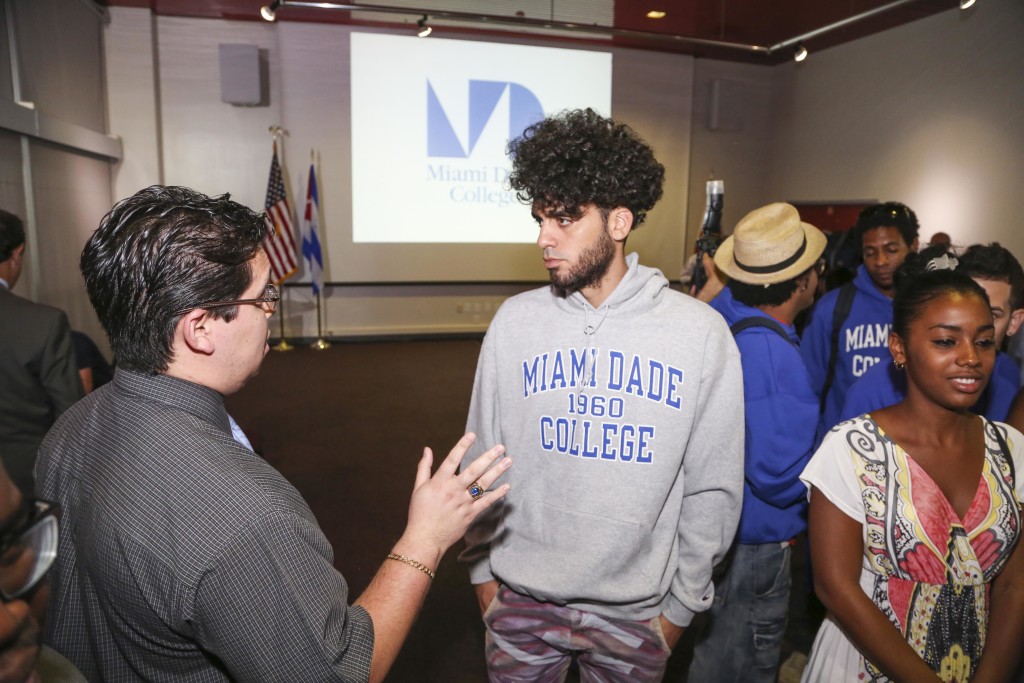College ‘Joyful But Watchful’ Over Freed Cuban Artist
Graffiti artist Danilo Maldonado Machado was freed from a Cuban jail on Oct. 20, nearly 10 months after he was first jailed for transporting two pigs with the names “Raul” and “Fidel” painted on them as artistic protest.
Maldonado Machado was charged with disturbing the peace with a political performance art piece on Dec. 25, 2014. He was previously on a hunger strike.
“I want to express my joy for this wonderful news at the same time I want to underline that it is a fragile situation,” said Juan Blanco, Executive Director of International Education and the Center for Latin American and Caribbean Initiatives at Wolfson Campus. “The same way he was arbitrarily detained without any formal charges and never brought to court, they can do that again to him. We should remain joyful but watchful.”
Blanco met Maldonado Machado when the artist studied at Miami Dade College last year with a group of 15 other Cuban dissidents, who were critical of the communist island government. The semester study abroad program was the first bridge of its kind for Cubans in 55 years.
The artist who is known by his artistic name “El Sexto,” had been jailed in Cuba without trial since his arrest this past December when he attempted to release two pigs labeled “Raul” and “Fidel” in a plaza in Havana for the public to catch and roast for their Christmas Eve feast.
In August, state officials told Maldonado Machado that he would be released, however, he remained in prison until his release on Oct. 20. He initiated a hunger strike on Sept. 8 in order to reclaim his freedom. On Oct. 1, El Sexto decided to end his hunger strike after a state official, acting as a mediator, promised that he would be released in fifteen days if he ended his hunger strike.
“His sentence is still unstated,” said Mariana Hernandez, of the Foundation for Human Rights in Cuba, shortly before he was released.
The Foundation for Human Rights in Cuba stands against arbitrary detention and advocates for the respect for human rights and freedom of speech on the Communist island.
Maldonado Machado’s friends and human rights organizations in and outside of Cuba have been waging a social media campaign protesting El Sexto’s imprisionment. A number of posts listed the telephone numbers at the prison and the Cuban embassy in Washington D.C. urging people to call to voice their protest. Media including the Miami Herald, BBC and The New York Times covered his plight. The human rights organization Amnesty International named Maldonado Machado a prisoner of conscience and urged people to protest his sentence.
A recent photo of El Sexto in jail showed the tall artist looking gaunt.
“Now that I started, I feel my faith, determination and self-esteem through the roof for having made this decision,” he wrote in a farewell letter from jail released on Sept. 16. “I am proud of being the artist that I am and make art that I do with the Cuba that I represent. So I am willing to give my life a hundred times if necessary.”
For Maldonado Machado, graffiti and art are ways of expressing himself and his beliefs. He created figurative and symbolic art, splashed across Havana’s walls, much of which was critical of the Castro regime. In a video on social media his mother stated he has been denied art supplies.
“These hard months haven’t changed him, if he doesn’t intend to do the same thing, he’s going to find an alternative way to express himself,” said Henry Constantin Ferreiro, a Cuba-based journalist, friend and former classmate of El Sexto.
Despite risk to those who speak out, the Foundation for Human Rights in Cuba continues to look for ways to continue bringing students to the U.S. for exchanges.
“I believe all of us can do something. I think that perhaps this is a way to enlighten people,” Blanco said. “This is a student of Miami Dade College who we know is facing that situation, and people might say ‘Oh well, that’s the way things are in Cuba.’ But that is a way that most people don’t like, even most Cubans don’t like it.”




